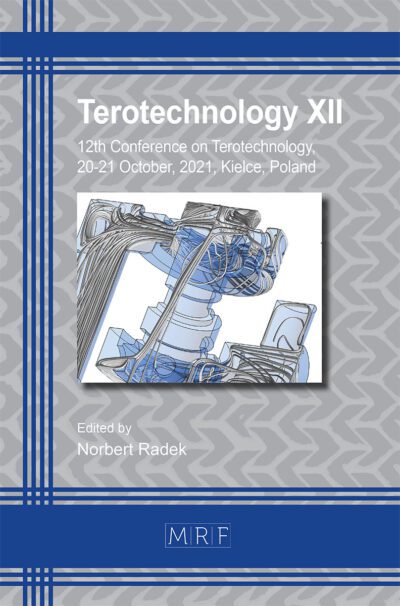–
Estimation of the residual stress field of laminated aeronautical parts to prevent distortion after machining
CHAABANI Khayel, BEN SAADA Mariem, LAVISSE Bruno, RITOU Mathieu, GERMAIN Guénaël
download PDFAbstract. The estimation of post-machining distortion of monolithic aeronautical parts induced by the redistribution of the bulk residual stresses (RS) during machining is one of the major challenges of aeronautical parts manufacturing. Since it is the main cause of thick parts post-machining distortion, it is essential to know the state of the initial RS so that the machining strategy can be modified to minimize distortion of each part. The problem is even more complex because the RS field is not identical from one part to another. Considering an average stress field provides satisfactory results only for parts with simple geometries and a highly repeatable manufacturing process, which is rarely the case in an industrial setting. By simulating the steps of the production of the laminated blank, the variability of RS field will be established. This variability can be used to determine the distribution of the RS field of each part during machining.
Keywords
Distortion, Residual Stresses (RS), Distortion Control, Simulation, Machining
Published online 4/24/2024, 10 pages
Copyright © 2024 by the author(s)
Published under license by Materials Research Forum LLC., Millersville PA, USA
Citation: CHAABANI Khayel, BEN SAADA Mariem, LAVISSE Bruno, RITOU Mathieu, GERMAIN Guénaël, Estimation of the residual stress field of laminated aeronautical parts to prevent distortion after machining, Materials Research Proceedings, Vol. 41, pp 2021-2030, 2024
DOI: https://doi.org/10.21741/9781644903131-223
The article was published as article 223 of the book Material Forming
![]() Content from this work may be used under the terms of the Creative Commons Attribution 3.0 license. Any further distribution of this work must maintain attribution to the author(s) and the title of the work, journal citation and DOI.
Content from this work may be used under the terms of the Creative Commons Attribution 3.0 license. Any further distribution of this work must maintain attribution to the author(s) and the title of the work, journal citation and DOI.
References
[1] Sim W-M (2010) Challenges of residual stress and part distortion in the civil airframe industry. International Journal of Microstructure and Materials Properties 5:446–455. https://doi.org/10.1504/IJMMP.2010.037621
[2] Li J, Wang S (2017) Distortion caused by residual stresses in machining aeronautical aluminum alloy parts: recent advances. Int J Adv Manuf Technol 89:997–1012. https://doi.org/10.1007/s00170-016-9066-6
[3] Tang ZT, Yu T, Xu LQ, Liu ZQ (2013) Machining deformation prediction for frame components considering multifactor coupling effects. Int J Adv Manuf Technol 68:187–196. https://doi.org/10.1007/s00170-012-4718-7
[4] Jeanmart P, Bouvaist J (1985) Finite element calculation and measurement of thermal stresses in quenched plates of high–strength 7075 aluminium alloy. Materials Science and Technology 1:765–769. https://doi.org/10.1179/mst.1985.1.10.765
[5] Denkena B, De Leon L (2008) Milling induced residual stresses in structural parts out of forged aluminium alloys. International Journal of Machining and Machinability of Materials 4:335–344. https://doi.org/10.1504/IJMMM.2008.023717
[6] Chatelain J-F, Lalonde J-F, Tahan AS (2012) Effect of Residual Stresses Embedded within Workpieces on the Distortion of Parts after Machining. 6:
[7] Lequeu P, Lassince P, Warner T, Raynaud GM (2001) Engineering for the future: weight saving and cost reduction initiatives. Aircraft Engineering and Aerospace Technology 73:147–159. https://doi.org/10.1108/00022660110386663
[8] Virkar AV (1990) Determination of Residual Stress Profile Using a Strain Gage Technique. Journal of the American Ceramic Society 73:2100–2102. https://doi.org/10.1111/j.1151-2916.1990.tb05276.x
[9] Tandon R, Green DJ (1990) Residual Stress Determination Using Strain Gage Measurements – Tandon – 1990 – Journal of the American Ceramic Society – Wiley Online Library. https://ceramics.onlinelibrary.wiley.com/doi/abs/10.1111/j.1151-2916.1990.tb06738.x. Accessed 5 Feb 2024
[10] Wei Y, Wang XW (2007) Computer simulation and experimental study of machining deflection due to original residual stress of aerospace thin-walled parts. Int J Adv Manuf Technol 33:260–265. https://doi.org/10.1007/s00170-006-0470-1
[11] Cerutti X, Arsene S, Mocellin K (2015) Prediction of Machining Quality due to the Initial Residual Stress Redistribution of Aerospace Structural Parts Made of Low-Density Aluminium Alloy Rolled Plates. International Journal of Material Forming 9:. https://doi.org/10.1007/s12289-015-1254-7
[12] Chabeauti H, Ritou M, Lavisse B, et al (2023) Digital twin of forged part to reduce distortion in machining. CIRP Annals 72:77–80. https://doi.org/10.1016/j.cirp.2023.04.021
[13] Lamba NK, Khobragade NW (2012) Uncoupled thermoelastic analysis for a thick cylinder with radiation. Theoretical and Applied Mechanics Letters 2:021005. https://doi.org/10.1063/2.1202105
[14] Louhichi MA, Poulachon G, Lorong P, et al (2022) Experimental and simulative determination of residual stress during heat treatment of 7075-T6 aluminum. Procedia CIRP 108:82–87. https://doi.org/10.1016/j.procir.2022.03.018

































